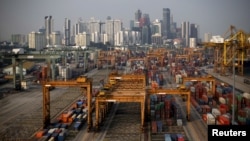When Singapore celebrated its 50th birthday as an independent country in August, the city state bore little resemblance to the tiny island nation that was expelled from Malaysia in 1965.
Years of strong growth have turned it into an international financial and shipping hub with spotless streets, well-tended parks and living standards unmatched in Southeast Asia.
Not only has its GDP per capita risen by more than 4,400 percent, according to government statistics, but its physical stature has swollen by 20 percent since independence thanks to one of the world's most aggressive land reclamation drives.
With a population of 5.5 million spread over just 719 sq km, Singapore has outlined plans to expand further over the coming decades, for both housing and for financial and industrial growth. Container terminals, industrial estates, petrochemical factories and the Changi Airport, repeatedly voted the world's best, are built on reclaimed land.
The Marina Bay Sands Hotel & Casino, and much of its expansive financial district, are also on land reclaimed from the seas from the 1960s to the 1990s. The bay area is home to some of Singapore's popular tourist destinations - a Ferris wheel, its $1-billion Gardens by the Bay park spanning 100 hectares and the Formula One Grand Prix circuit.
Environmental Damage
But Singapore's success and an influx of foreign workers has brought high property prices, crowded public transport and a widening wealth gap which have fueled resentment among many in a city that surveys rank as one of the world's most expensive.
The extent of its land reclamation has come under criticism for causing environmental damage and caused tension with its neighbors. It has lead to loss of marine life, destruction of mangrove area and coral reefs, critics say.
Singapore's terrain is largely flat today - it used the earth from its hills for reclamation. With no more material available within its borders, Singapore has imported 517 million tons of sand in the last 20 years, according to a United Nations report last year.
Indonesia, which was the biggest supplier of sand to Singapore, banned exports to the city state in 2007, saying sand mining caused the extinction of several fish species, destruction of coral reefs and the disappearance of a number of small islands.
Environmentalists also say reclamation is causing change in tidal flows, not just at Singapore's coasts but also those of its neighbors. In 2011, Singapore raised the minimum height of land reclamations to protect itself from rising sea levels.
With the island's population expected to increase to 6.5-6.9 million by 2030, the government has said it will need another 50 sq km of land. It detailed a plan in 2013, marking out areas it could reclaim for military training, industrial and port uses.
Singapore has also said it has room for further reclamation beyond 2030. That may not be easy amid growing environmental and political objections.






